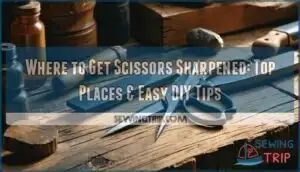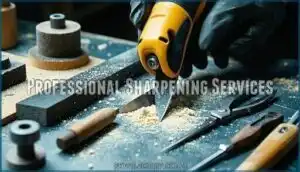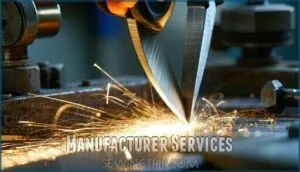This site is supported by our readers. We may earn a commission, at no cost to you, if you purchase through links.
 You’ve got options regarding where to get scissors sharpened.
You’ve got options regarding where to get scissors sharpened.
Check professional sharpening services, often found in hardware or specialty shops.
Many fabric stores also offer sharpening, which makes sense since they work with precision cutting tools.
Manufacturers sometimes provide this service if your scissors are a specific brand—check the warranty or website.
Mail-in sharpening services add convenience, letting you ship scissors off and get them back razor-sharp.
If you’re feeling handy, DIY options like sharpening stones or aluminum foil can work for quick fixes.
To keep scissors sharp longer, proper handling and maintenance make all the difference, ensuring your scissors remain in good condition with regular maintenance.
Table Of Contents
Key Takeaways
- You can get your scissors sharpened at hardware stores, fabric shops, or through mail-in services. Check for local options or scheduled events.
- Manufacturer services often guarantee factory-level precision and warranty protection for specific scissor brands.
- DIY sharpening methods like using aluminum foil or sharpening stones work for quick fixes, but professionals deliver better results for specialty shears.
- Maintain scissors by cleaning blades, using them only for their intended materials, and oiling the pivot point regularly to keep them sharp longer.
Professional Sharpening Services
Professional sharpening services offer a reliable solution when your scissors lose their edge.
Local sharpening experts like Potomac Sharpening and TogiMax provide specialized care with turnaround times ranging from same-day to a week.
Mobile sharpeners even come to your location, saving you time.
Pricing factors typically range from $8-35 per pair, depending on scissor type and sharpening expertise required.
Many professional services use state-of-the-art technology to restore your blades to factory specifications.
State-of-the-art sharpening restores your scissors to factory precision, ensuring flawless performance and extended blade life.
Edge shape matters for fabric shears, so professional services are recommended.
When choosing a scissors sharpening service, compare service providers based on their experience, pricing, and customer reviews.
Manufacturer Services
Many top scissor brands stand behind their products with manufacturer sharpening services that keep your cutting tools in prime condition.
When you send your scissors back to their makers, you’ll enjoy several advantages:
- Warranty protection remains intact, guaranteeing your investment stays protected
- Restoration to exact factory specifications by technicians who know your specific model
- Professional treatment that maintains the brand reputation for quality and performance
- Consistent results that match the original cutting experience
Most companies like Kai and Gingher charge between $10-15 per pair, while specialized services like C.L. Sturkey run about $22.00.
The turnaround time typically ranges from 1-4 weeks depending on the manufacturer. Some premium brands even throw in free lifetime sharpening with your purchase.
Mail-in sharpening services are straightforward – simply package your scissors securely and include return shipping. While national chain stores offer convenience, sending scissors directly to their manufacturer guarantees the highest quality results.
Local Hardware Stores
Your local hardware store can be a hidden gem for scissors sharpening needs. Many family-run shops offer on-site sharpening services that keep your cutting tools in top shape.
Local hardware stores are a treasure trove for affordable, trusted sharpening services that restore your scissors to peak performance.
| Service Type | Availability | Pricing | Wait Time |
|---|---|---|---|
| On-site sharpening | Often weekly | $5-10 per pair | Same day to 1 week |
| Drop-off service | Most stores | Varies by brand | 2-3 days |
| Tool brand expertise | Store-dependent | Free with purchase | Immediate |
| Specialty scissors | Limited availability | Higher for precision | By appointment |
Call ahead to confirm service availability, as not all hardware stores offer sharpening services. Some even provide loaner scissors while you wait. You can find sharpening product options at these locations, which may offer on-site sharpening and tool brand expertise for a variety of scissors sharpening needs.
Fabric Stores
While hardware stores offer general tool maintenance, fabric stores specialize in keeping your cutting tools in top shape.
Fabric stores are excellent places to get your scissors sharpened, often providing services specifically designed for sewing and crafting tools.
Joann Fabrics partners with ProEdge Sharpening to offer professional scissor sharpening through both in-store options and mail-in services.
They regularly host Live Events where experts sharpen scissors while you wait, typically charging between $3 and $10 for sewing shears under 10 inches.
You can drop off your scissors up to six days before scheduled events, making it convenient to plan around your busy schedule.
Vogue Fabrics offers quick 1-2 day turnaround times, while Eureka Fabrics handles most types except hair scissors and serrated blades.
Many options exist for sharpening related products.
Finding scissors sharpening near me is as simple as calling your local fabric store to ask about their service partnerships or upcoming sharpening events.
Most scissor sharpening costs start at $7.
Mail-in Services
After exploring fabric stores, you’ll find mail-in services offer another convenient option for scissor sharpening. These services let you ship your scissors directly to professionals without leaving home.
Mail-in sharpening services typically offer:
- Free shipping labels from companies like Sharpen by Mail
- Turnaround times ranging from days to 4 weeks
- Service variety for all scissor types including beauty, barber, and sewing shears
- Proper packaging safety guidelines to protect blades during transit.
Prices vary based on scissor type, with specialized shears costing around $25-55 per pair. Most services provide tracking options so you can monitor your scissors’ journey from drop-off to return delivery.
DIY Sharpening Methods
Several effective DIY scissor sharpening methods exist for maintaining your cutting tools at home.
Diamond plates offer precision sharpening, while the whetstone technique provides excellent results with proper angle consistency.
Simply cut through aluminum foil 10-15 times or use fine-grit sandpaper to restore edges quickly.
For best results, apply light pressure and focus on burr removal after sharpening.
Remember to add a drop of household oil for proper lubrication options.
Most DIY methods require minimal tools – a sharpening stone, sharpening steel, or even everyday items can transform dull scissors.
Watch a reliable sharpening tutorial before attempting for the first time.
Tips for Maintaining Sharp Scissors
With proper maintenance, your scissors will stay sharp longer than you might expect.
Keep them cutting cleanly with these simple care tips:
- Clean blades after each use to remove debris that causes dulling
- Store scissors in protective cases or sheaths to prevent edge damage
- Use scissors only for their intended materials—paper scissors for paper, fabric scissors for fabric
- Inspect blades regularly for nicks or alignment issues
- Apply a drop of oil to the pivot point every few months
Regular preventative care reduces sharpening frequency and extends scissor longevity.
Wipe blades with alcohol occasionally to remove buildup.
To avoid rust, dry them thoroughly after use.
When cutting, use the middle portion of the blades for peak performance.
Frequently Asked Questions (FAQs)
Does JoAnn’s Fabrics sharpen scissors?
Imagine this: dull scissors ruining your fabric dreams.
At JoAnn Fabrics, you can get scissors sharpened through their ProEdge Sharpening service.
Just check for live events or mail-in options for convenience!
Can you sharpen salon scissors?
Yes, you can sharpen salon scissors.
It’s best to use professional sharpening services since salon shears require precise care.
Experts guarantee the blades stay sharp without damage, keeping your cuts clean and precise.
What type of scissors can be sharpened?
Keeping scissors sharp is like giving them a second life.
You can sharpen kitchen shears, sewing scissors, salon shears, garden tools, and even specialty scissors.
Regular sharpening keeps them effective, safe, and ready to use.
How often should scissors be sharpened?
You should sharpen scissors every 6-12 months, depending on use.
Heavy daily use might require sharpening sooner.
Dull blades but also damage materials, so keep them sharp for smooth cutting, as this slows you down.
Does sharpening scissors damage them?
About 90% of scissor damage comes from improper sharpening methods.
Done correctly, sharpening won’t harm them—it restores performance.
But avoid DIY attempts if unsure, as a pro knows how to maintain the blade’s edge and balance.
Are there any risks associated with sharpening scissors?
Sharpening scissors isn’t risky if done correctly, but using improper tools or excessive force can damage the blades.
Uneven sharpening might cause misaligned edges, so it’s smarter to follow guides or trust a professional service.
How can I tell if my scissors need sharpening?
If your scissors start tearing or crushing instead of cutting cleanly, it’s time to sharpen them.
Uneven edges or a gritty feel while cutting are other telltale signs that they need attention.
What equipment is used for high-precision sharpening?
Precision sharpening is like painting with a fine brush—it requires tools like diamond stones, whetstones, rotary tools, and honing guides.
These tools guarantee accurate angles, smooth edges, and long-lasting sharpness for a perfect finish.
Are mobile sharpening services more cost-effective?
Mobile sharpening services can save you time and money, especially for multiple tools.
They’re convenient, often offering same-day service.
Plus, you avoid shipping costs, making them a budget-friendly choice for quick, expert results, with same-day service often available.
How often should scissors be professionally sharpened?
You should have scissors professionally sharpened every 6-12 months, depending on use.
If they start snagging, cutting poorly, or losing precision, it’s time.
Regular sharpening keeps them efficient and saves you frustration in the long run.
Conclusion
Did you know dull scissors can reduce cutting efficiency by up to 50%? Knowing where to get scissors sharpened can save you time and effort.
Whether you choose professional services, mail-in options, or local stores, there’s a method for every need. DIY techniques work in a pinch, but regular maintenance is key.
Keep scissors clean, avoid cutting inappropriate materials, and store them properly. Sharp scissors last longer and deliver better results with the right care.











